Reese Witherspoon: Activist, Advocate, Hollywood’s Moral Compass
Reese Witherspoon Vogue Cover Photographed by Zoë Ghertner
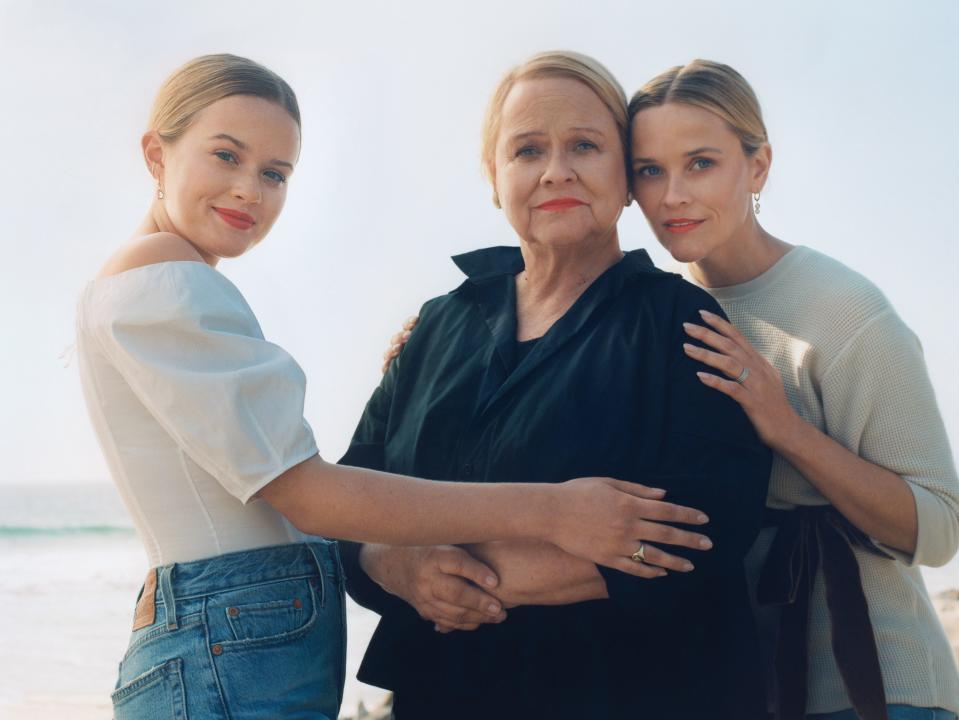
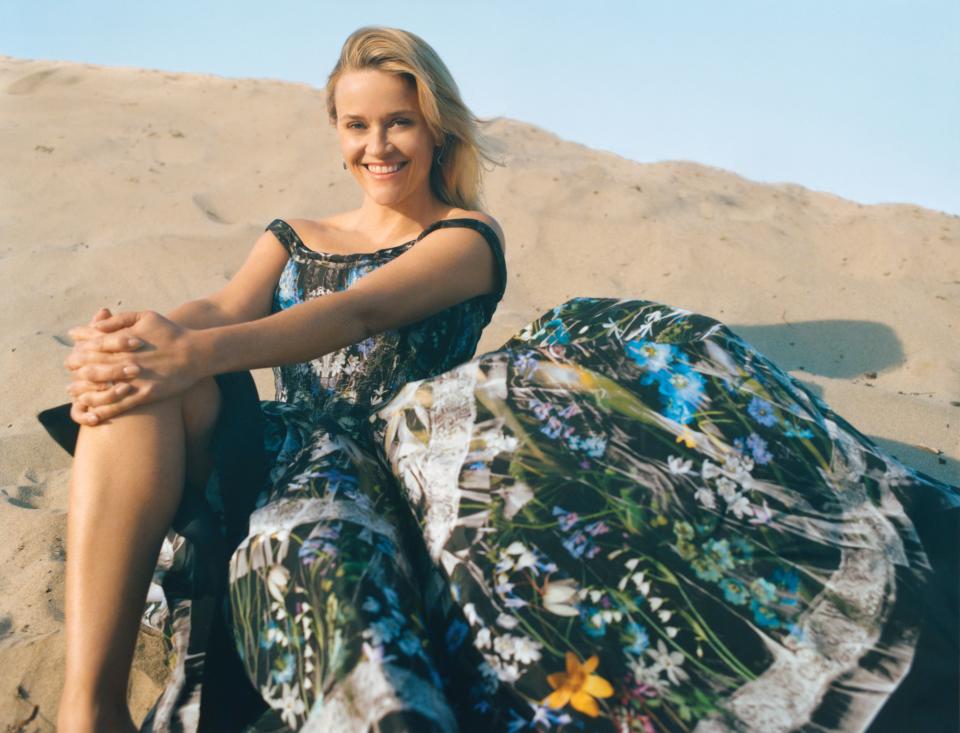
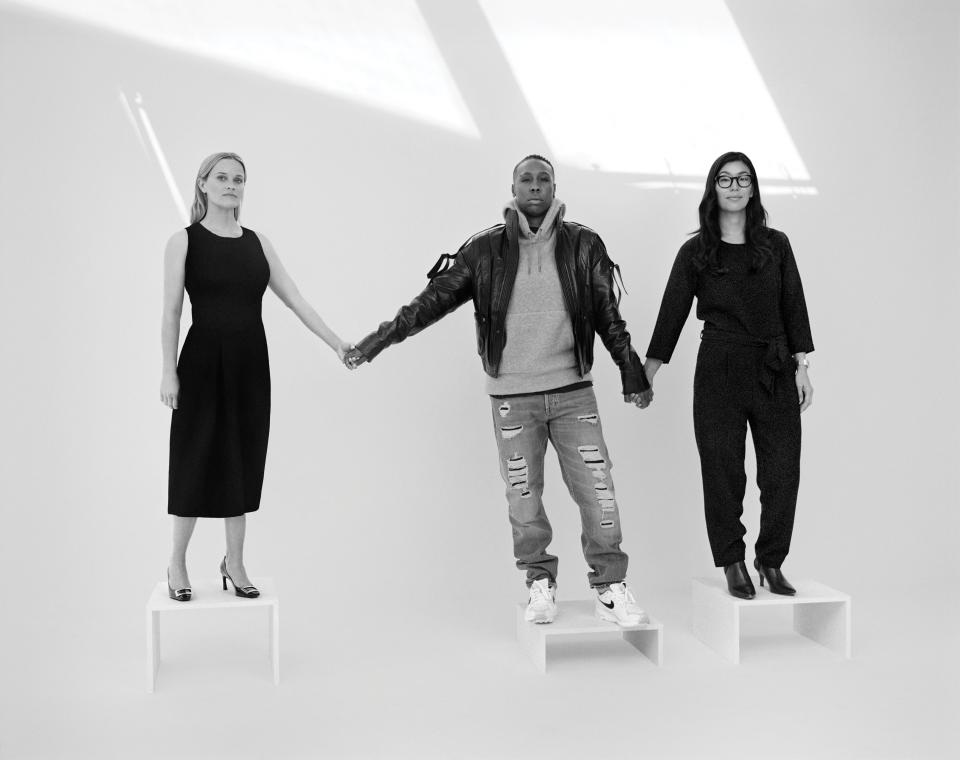

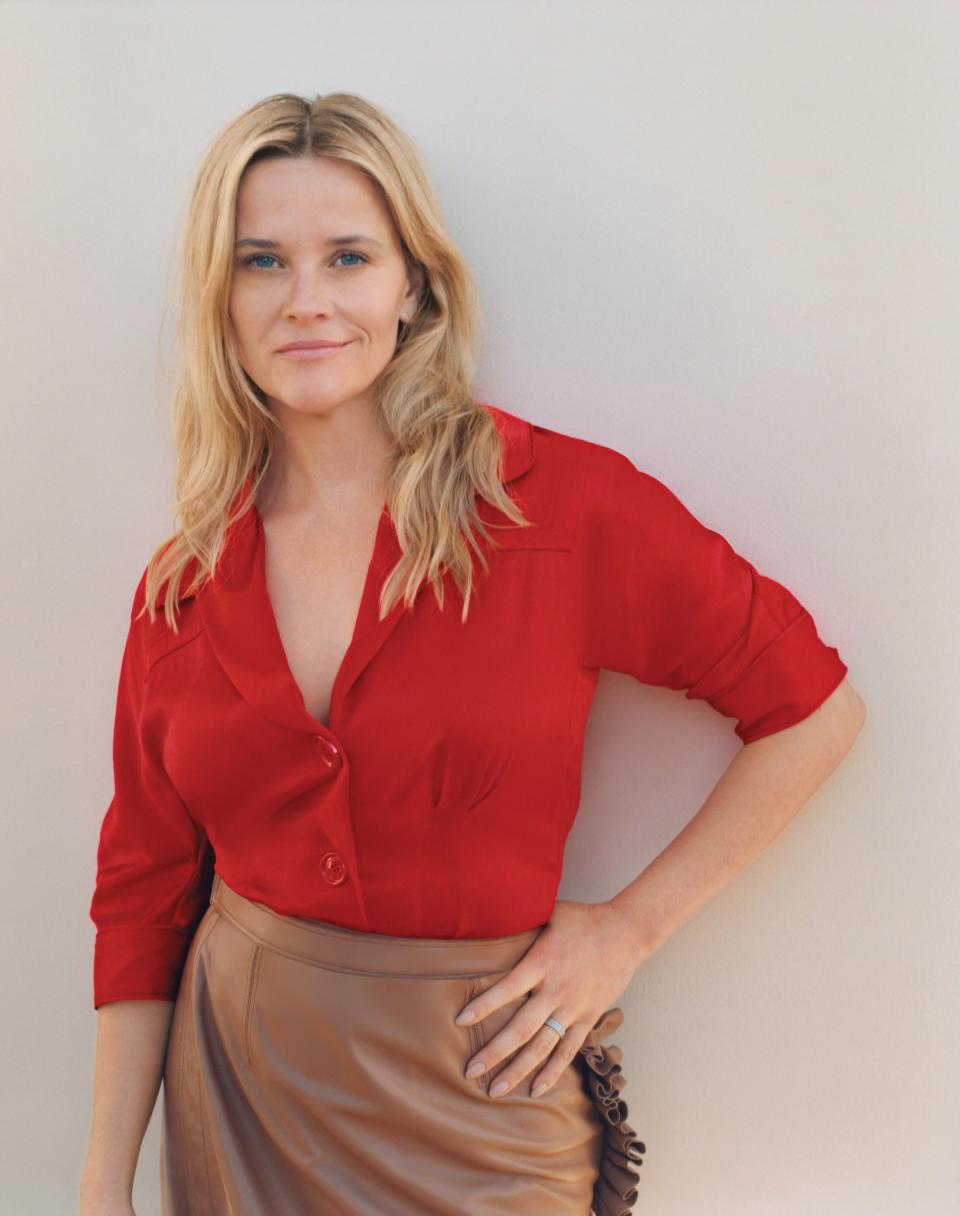
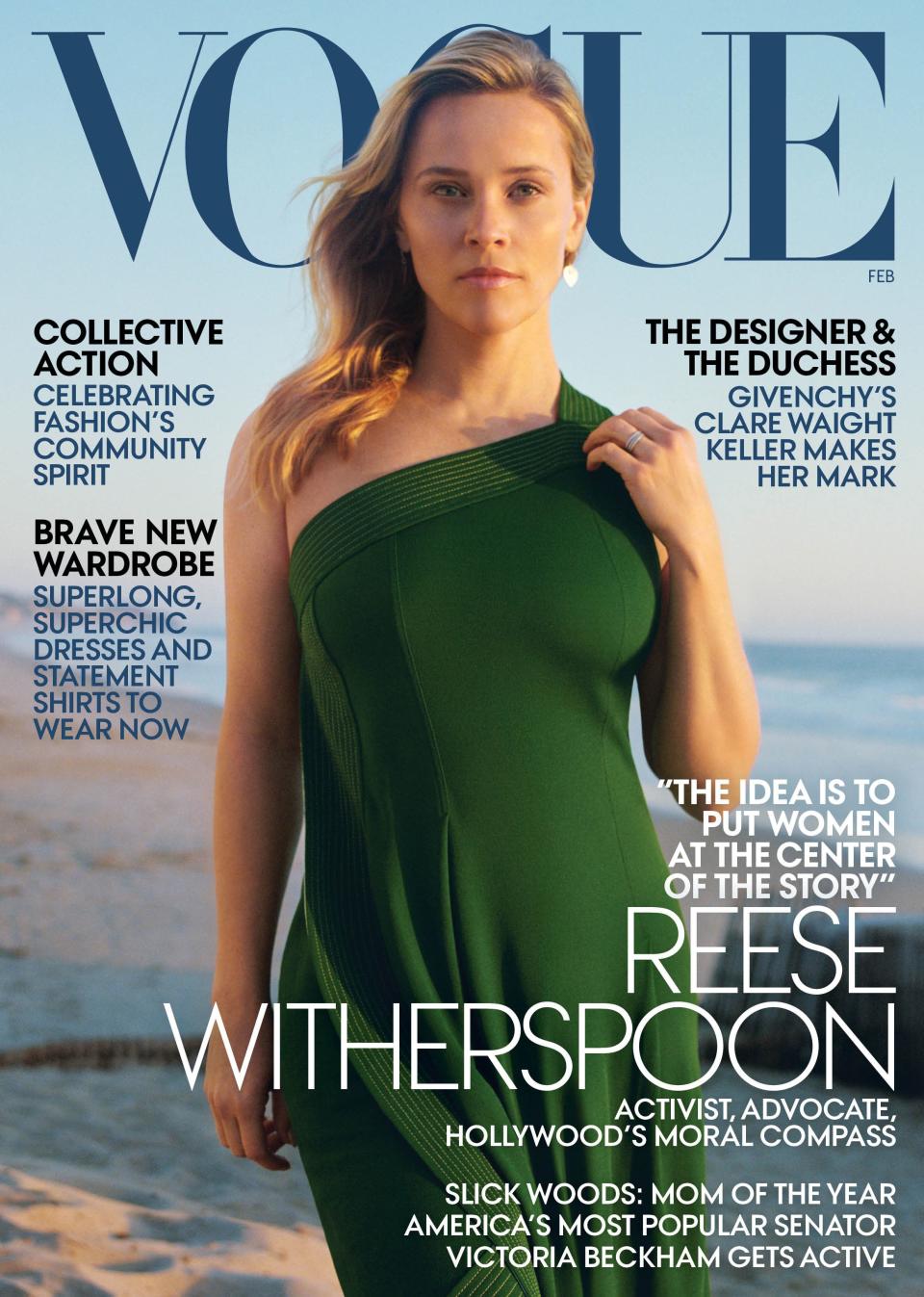
The first time Reese Witherspoon found herself suspended from school was in third grade, when she was caught running a custom-barrette business from her desk. (She painted store-bought barrettes and sold them at a profit; when her paint pens leaked onto her desk, she was apprehended.) Another time was during her junior year, at a private girls’ high school in Nashville, when she complained to her English teacher that the work they were doing wasn’t challenging enough. Witherspoon was in many ways a model student—good grades, popular, a soccer player and cheerleader—but she also had a reputation for telling teachers what they were doing was wrong.
“I always tended to be outspoken with my opinions,” she says. “Whether they were appropriate or not.”
More than two decades later, Witherspoon is still fighting the status quo. Insofar as Hollywood is an extreme version of high school, a fishbowl of fragile egos, insecurity, and often-misdirected sexual energy, she has taken it upon herself to be a champion of the overlooked and the underestimated. She may still bear the imprint of the perky-blonde roles that kept her in American-sweetheart mode for the better part of two decades, but something’s changed beneath the surface. Witherspoon has become a formidable businesswoman, launching a company that has a hand in just about every imaginable sector of contemporary media, and she’s become a formidable activist as well, fighting for greater representation in Hollywood of people of color, LGBTQ people, people with disabilities, and—most of all—women.
“The idea is to put women at the center of the story,” Witherspoon says, sitting barefoot and in jeans in the kitchen of her sunny, sprawling Los Angeles home as her three dogs—a German shepherd named Nash (short for Nashville), a French bulldog named Pepper, and a lab named Hank—amble and snort among the rooms. “I was sick of making movies where I was the only female lead on the set. I was sick of seeing scripts where there was one female role, badly written, and yet every actress in town wanted the part because there was nothing else.”
What Is Reese Witherspoon Really Thinking? Vogue’s New Original Short Pulls Back the Curtain:
There is perhaps no greater example in the history of television of putting women at the center than Big Little Lies, the HBO sensation that picked up eight Emmys in 2017. Witherspoon executive-produced the series with Nicole Kidman, with whom she also stars alongside Laura Dern, Zoë Kravitz, and Shailene Woodley. In the second season, which airs in late spring, Meryl Streep will bring the show’s number of female leads to six.
Big Little Lies is just one plank—albeit a very wide and glossy plank—on Witherspoon’s endlessly expanding platform. “I finally asked myself, Why does it have to be the same 20 people making all the movies?” she says. “Maybe there is room for a more inclusive idea about who can be on-screen and who can get it funded. Maybe there are different ways to get content made so that the world we see on-screen looks more like the world we walk through in real life.”
The control center for this mission is Witherspoon’s company and “storytelling brand” Hello Sunshine. Originally founded in 2016, and following the success of her production company Pacific Standard, which made the megahit Gone Girl as well as the critically acclaimed Wild, Hello Sunshine is now beaming its rays to seemingly every corner of the media landscape. In the last year, it has expanded its reach with something like 20 new projects (it’s almost impossible to tally them all) in some stage of development or implementation.
Many are for film or television—and have grown out of books picked by Witherspoon for her book club, an Oprah-like venture that lives chiefly on Instagram, where its total number of followers inches toward 800,000. Celeste Ng’s best-selling 2017 novel Little Fires Everywhere will stream on Hulu later this year as a limited series starring Witherspoon and Kerry Washington. Apple TV has greenlit three Hello Sunshine projects, the first of which will be The Morning Show, a behind-the-scenes drama about the morning television network-news business, in which Witherspoon stars alongside Jennifer Aniston and Steve Carell. With a reported production budget of $240 million, The Morning Show is one of the priciest deals in television history.
There’s also (and here’s where it gets hard to count) two podcasts; a mentorship program for young aspiring female filmmakers; a YouTube channel; a series of live stage events; a deal with Audible to produce original audiobooks; and a subscription channel, which will also live on DirecTV, that provides unscripted female-created programming, including Shine On with Reese, an interview show where Witherspoon talks with various women of note. The first episode of Shine On had her rifling through sequined gowns in Dolly Parton’s closet.
And although they don’t fall officially under Hello Sunshine’s auspices, there are Witherspoon’s fashion–and–home accessories line, Draper James, and her recent best-selling book, Whiskey in a Teacup: What Growing Up in the South Taught Me About Life, Love, and Baking Biscuits.
Witherspoon made her first movie at fourteen. She’s now 42 but looks about 32—her blue eyes lighting up a bright, lineless face—and talks like someone who has fully embraced a seasoned, adult version of herself. She’s happy to open up about the characters that shaped her career—“Tracy Flick would definitely be holding national political office by now,” she says—but she seems to sit up a few inches taller when the subject turns to business. She loves to talk about funding sources, social media, and the viewership data that are now available thanks to streaming technology. She’s fluent, too, in the language of modern social justice—telling me about “increasing representation of people from marginalized groups” and no longer “being dependent on the incumbent power structure.”
All of this started around 2014, when Witherspoon made Wild. Based on the memoir by Cheryl Strayed, Wild was funded out of Witherspoon’s own coffers and gave her the chance to play a new kind of character. Her subtle, nuanced performance of a troubled woman on a three-month trek along the Pacific Crest Trail won her an Oscar nomination—and fortified her commitment to finding complex, interesting roles for other actresses in Hollywood.
“From the very beginning I knew that Reese had a sense of mission as a feminist,” says Strayed, who’s become a close friend. “But her public persona seemed to shift with Wild. During the press tour, people would say, ‘But you’re America’s sweetheart! You’re this cute little blonde girl!’ Not anymore. It was the beginning of the next era of Reese’s career and life.”
WITHERSPOON LIKES to say “y’all.” Outside her house are welcome mats that read “hey y’all.” You can purchase Draper James tote bags that say “totes y’all” and sweatshirts that say everything from “vote y’all” to “be kind y’all.” Hello Sunshine’s line of custom gift boxes offers a seasonal box called It’s Fall, Y’all.
But she also uses the word intersectional, which is common to the parlance of social justice and refers to a particular framework for looking at feminism. Lest you think there’s any incongruity between talking like a Tumblr feminist and publishing a book about Southern gentility that includes tips on hosting Kentucky Derby parties, Witherspoon will tell you that “we have to stop thinking about things as extremely one way or another. Things are not binary. There’s a whole lot of stuff in the middle.”
“There is a lot of pressure in the world about who is supposed to care about politics, who is supposed to be in charge, who is supposed to be an activist,” says Washington. “And Reese has given a very genteel, Southern, ladylike middle finger to all of it. She is going to care about who runs the country and who has power and intersectional feminism and remain the beautiful, blonde, genteel Southern woman that she is.”
As Witherspoon circulates among the staffers at the sleek, loftlike Hello Sunshine offices in Santa Monica, her Draper James fitted dress, Sarah Flint x Cindy Crawford heels, and bright-red lipstick make her stand out so much that it’s almost as if a spotlight is tracking her. When she leads her all-female executive team to a nearby restaurant for their weekly lunch meeting, clutching her Fendi purse and wearing Ray-Bans that seem almost to tilt her face toward the sun, just about every head in the place turns and takes discreet notice. No one bothers her, but against a sea of black sweaters and premium denim, it’s hard not to think of Legally Blonde’s Elle Woods waltzing through Harvard Square in pink leather.
“She’s so noticeable and recognizable that she just owns it,” says Ng, who first met Witherspoon at a conference. Later the two sat down for a Facebook Live Q&A about Little Fires Everywhere. “She’s saying you can be blonde and gorgeous and wear really cute dresses and also be a smart businesswoman; those things are not in conflict with each other.”
At lunch, Witherspoon orders a kale-and-lentil salad with chicken and sits in rapt attention while her team, led by Hello Sunshine CEO Sarah Harden, runs through the week’s business affairs—the writers and directors they’re excited about; the eclectic lineup at Together Live, a series of stage events featuring women writers and performers. Witherspoon is prone to enthusiastic interruption: “Sorry! I know I have ADD!” she exclaims at one point, waving her hands over her salad as she stops a colleague mid-sentence. She wants to hear more about what’s happening in the Little Fires Everywhere writing room and needs to be reminded about the shooting schedule for The Morning Show, but she also wants to discuss plans for the company holiday party. Should it be in the office or should they rent a venue? She needs advice, too, about what she should say at an upcoming speaking event on female entrepreneurship.
The flurry of suggestions appear to line up in orderly fashion as they enter Witherspoon’s brain. She smiles, registering a new thought: “You know what would be great for my school fund-raising auction?” she says. “The opportunity to sit down with successful entrepreneurial women and ask them things. Just two hours would be amazing!”
ASK WITHERSPOON’S FRIENDS about her most notable qualities and they all, to a person, express awe at her near-supernatural ability to multitask. “Honestly, I’ve never seen someone process information the way she does,” says Kidman. “She can learn dialogue faster than anyone I’ve ever seen. It’s an incredible skill. So much of her life is effortless like that.”
In addition to those something-like-20-but-who’s-counting professional projects, Witherspoon has a nineteen-year-old daughter, Ava, and a fifteen-year-old son, Deacon, with ex-husband Ryan Phillippe. In 2011 she married CAA agent Jim Toth, with whom she has a six-year-old son, Tennessee. She keeps a home in Nashville, where her parents, brother, and much of her extended family still live. Whiskey in a Teacup is full of instructions on the domestic arts—how to serve Mississippi mud pie in a trifle dish; how to make monogrammed scrapbooks—and you’d better believe Witherspoon knows what she’s talking about.
“She does everything!” Meryl Streep says. “On top of the acting and producing and the books and Draper James, she also carves the pumpkins! She raises three kids. She maintains friendships. I know what it’s like to be in this business and also raise kids. You remember that book I Don’t Know How She Does It? That’s Reese!”
Witherspoon was a young mom. She gave birth to Ava when she was 23, just a year before making Legally Blonde—“There are pictures of her as a baby on the set,” she says. Her own mother, Betty, was a labor-and-delivery nurse at Nashville’s Vanderbilt hospital, and Witherspoon remembers going to work with her and watching her “take care of seventeen babies at once. There would usually be two women, and they’d be doing all the diapering, all the feeding—everything, all at once,” Witherspoon recalls. “And the crying of the babies! The noise! She said she didn’t even hear it. I remember being so in awe of my mom. She always had a positive attitude, always laughing, always telling a joke, and she always had a billion friends at work. She just loved the women she worked with.”
If loving the women you work with is a common refrain in Witherspoon’s life these days—“I can’t even tell you how much fun and how rare something like that is,” Kidman says of the collaborative spirit of Big Little Lies—its most powerful manifestation probably comes from Witherspoon’s involvement in Time’s Up, the #MeToo-inspired movement fighting for better working conditions for women in Hollywood and beyond.
Organized in the wake of the allegations against Harvey Weinstein, Time’s Up came to wide public attention via the Golden Globes awards ceremony last year, where stars dressed in black and wore commemorative Time’s Up pins (which Witherspoon commissioned from costume designer and stylist Arianne Phillips) to show solidarity. Thanks to the efforts of Witherspoon and other powerful industry women like Shonda Rhimes and Eva Longoria, a legal defense fund has been created to help women arm themselves when they make complaints against employers. And although the far-ranging scope of the mission can leave the movement open to questions about what it’s actually accomplishing, those inside insist that big things are still to come. Last fall, former WNBA president Lisa Borders was named chief executive; meanwhile, there’s ongoing excitement about initiatives like 50/50 by 2020, which seeks to combat harassment by increasing gender parity in Hollywood, where the vast majority of writers and directors are still men.
Witherspoon has spoken publicly about having been sexually assaulted on a movie set when she was just sixteen, though it’s not something she particularly cares to dwell on. As for the Weinstein scandal, she says the urgency to take action came not just from the shock of the allegations but also from her dismay over not having been aware of the extent of them.
“I think I felt like a lot of people in that I was shocked that I didn’t know,” she says of the Weinstein revelations. “I’d heard rumors, but then again I’ve heard rumors about me that aren’t true! I always try not to judge people based on rumors. I never in my imagination thought that any of that was happening. I did not. And here I am.”
Where she is could be described as at the pointy end of the movement, not just because she’s an A-list movie star who can get people’s attention but because of those formidable organizational skills. (Incidentally, Witherspoon’s lobbying for pay equity reportedly spurred HBO to reevaluate its entire salary structure and close its remaining wage disparities.)
“She actually comes up with ideas and strategies,” says Master of None star Lena Waithe, who first met Witherspoon last year at a dinner to celebrate Big Little Lies and now works with her in Time’s Up. “If you get a bunch of people in a room talking about problems, they can keep talking for hours. But she can say, ‘All right, everyone said their piece; let’s talk about the solutions!’ ”
“I don’t know if people understand how strategic and intentional she is,” says Ai-jen Poo, a labor activist and MacArthur “Genius” Fellow who directs the National Domestic Workers Alliance and is closely aligned with Time’s Up. (Poo accompanied Streep to that storied Golden Globes ceremony.) “She’s building a company and a platform and elevating women in all of the channels of what she’s doing. She recognizes and takes responsibility for the fact that she has a really broad audience; she’s an influencer across a wide swath of people. She has the ability to reach them.”
IN THE LOBBY of a Chicago theater, thousands of women are buzzing around buying wine, checking out Hello Sunshine merchandise (which includes things like #teamsunshine baseball caps and plate necklaces that say “strong female lead”), and waiting in line for the restroom before the start of a Together Live show in which Witherspoon will appear. Among the throngs of well-heeled, young-to-early-middle-aged women dressed fashionably yet sensibly for the chilly weather are a handful wearing pink suits and pillbox hats in homage to Elle Woods.
When the show gets under way, Witherspoon strides out with the other participants, waving and smiling and then taking a seat and chiming in only occasionally until she comes center stage for an interview. Wearing a polka dot, ruffle-sleeved Draper James dress, she doles out soupçons of inspiration as though they were the cheddar biscuits she extols in her book.
“Sharing our stories is the antidote to the disconnection that divides us.”
“If you want something done, do it yourself. Sometimes you don’t know you can do it, but you do it anyway!”
As with every Together Live speaker, each apothegm is met with exuberant applause.
To watch all of this is to wonder if perhaps Witherspoon is trying a little too hard to be an Oprah figure. Sure, she wants to create opportunities for women, herself included, but does she really need the clothing line, the book, the DirecTV channel, the multiple film and television projects? (Including, by the way, Legally Blonde 3, with a targeted release in 2020.) Witherspoon already has an estimated net worth of $120 million. Does she really need to build an empire by branding some generalized notion of female empowerment?
The roots of some of this ambition may still be too far underground to try to pull up quite yet. There have been tabloid rumors in the past that Witherspoon’s father, an ear, nose, and throat doctor, has had troubles with alcohol and money, among other things. (Witherspoon herself was arrested for disorderly conduct in 2013 when she berated an Atlanta police officer who pulled her and Toth over for suspected drunk driving.) But, as Witherspoon points out, plenty of rumors aren’t true. For now, she will only hint at the anxieties that underpin some of her ambition. She may have grown up a doctor’s daughter with a private school education and a houseful of monogrammed napkins and hand towels. But that was not the whole story.
“I’m not really at liberty to talk about my family’s finances,” she says. “I don’t think it’s appropriate. But it’s not what it seemed like. There is a book I will write one day that is probably a little more. . . .”
Here she takes a long pause and finally continues: “There were just . . . there are reasons I’m passionate about a lot of things, you know? I think there’s a time and a place and there will be a moment when I can speak about it. But there’s a reason I’m very passionate about women having their own money. I have a lot of friends and I have a lot of personal experiences with women feeling afraid and making life choices because they felt completely paralyzed or in a stasis because they didn’t know what to do financially. And you can’t have liberation if you don’t have that.”
As she speaks, a cloud seems to pass over her momentarily, casting a faint shadow upon her flawless face. But the next thing you know she’s sunny again. She springs up from the kitchen table to give a tour of her house, at least the downstairs portion, where family photos commingle with award statues, including the Best Actress Oscar she won for her portrayal of June Carter in Walk the Line.
“I used to hide my Oscar,” she says. “But then I was like, Why shouldn’t I put it out here in the living room?” On the shelves, hardbound scripts of most of the movies Witherspoon has made sit in stacks and remind you of the sheer breadth of her work. Legally Blonde 2: Red, White & Blonde sits atop Twilight, which rests atop Wild. Water for Elephants rests atop Devil’s Knot. Outside the front door are giant pumpkins (not carved; Halloween has passed) and of course those “hey y’all!” welcome mats.
There’s a lot of “y’all” in Witherspoon’s world, both as a speech contraction and as a style motif. It’s a testament to knowing your audience, but it’s also the signature of Witherspoon’s call for collaboration. It’s the embodiment of her approach to inclusivity, a demand for action wrapped up in a friendly, accessible package. Those who underestimate it do so at their peril. As Strayed puts it, “Reese was never anyone’s sweetheart. We just thought she was.”
For now, Witherspoon, when she’s not running in a dozen directions at once, is basking in just a little bit of vindication. After years of banging her fists on the table—“and banging my head against the wall,” she says—the culture has finally begun to catch up with her.
“I didn’t think a moment like this was going to happen,” she says, cradling Pepper, the French bulldog, in her arms. “We’re not there yet. But I lay down and dreamed of all this stuff seven or eight years ago and now it’s finally starting to happen. I guess what I do now is start thinking of some more dreams.”
Watch Reese Witherspoon Inside Her L.A. Home, on Her Dream Cameo, and More:

